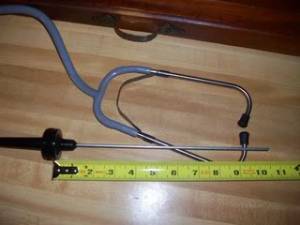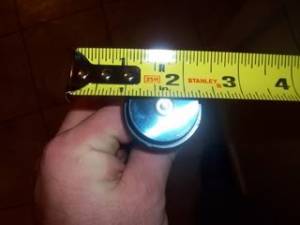Table of Contents
This is an old revision of the document!
REF: General-MSR 06
Using a Stethoscope or Other to Hunt Down Engine Noises
When you're riding, it's even harder to pinpoint where the noise is generating from. 1)
You can use a stethoscope, screwdriver or a length of hose or an older method with a wooden stick.
A stethoscope can be purchased inexpensively at Princess Auto, Harbor Freight or others.
If you haven't listened to your healthy engine before with either screwdriver or stethoscope etc., 2)
You've got no reference or comparison as to what you should be listening to when your engine isn't so healthy.
With a bit of experience, it's easier with these to pin point if you're listening to a full speed or a half-speed noise.
That can help in diagostics as in crank versus cams.
But the 1st time you're using them on a very healthy engine, it just sounds like it's gonna blow any minute.
However, use caution when using a stethoscope.
It has a diaphragm in the middle of the tube (attached to the probe rod) that amplifies the sounds that you are hearing. 3)
This amplified sound can hurt your ears when simply scraping the probe across engine parts (or even your finger).
| Mechanic stethoscope. 4) The black partition at the end of the tape measure is where the diaphragm is. Note the size of the diaphragm. |
|
 |  |
A wooden dowel also works well. 5)
Hold one end to the engine and stick the other end against your ear.
The dowel not only lets you hear the sounds but it will also let you feel them.
There is a distinct difference in feel on the wood from a ticking noise and a knocking noise.
A stethoscope may sound louder in this instance.
But a wooden dowel may feel a harder tap easier.
With the engine at idle listen at:
- All 4 rocker ends, both sides of the engine.
- All 4 pushrods, top, middle and bottom.
- All 4 lifter blocks.
- All 4 cams, listening thru the gearcase cover.
- Both ends of the generator (if applicable).
All similar points should sound about the same, like rotating steel parts.
For exhaust leaks:
- Listen around the head ports and any joints for a ticking sound.
For future maintenance:
It is worthwhile to do this process a couple of times a year, just to keep track of stuff.
It's also a very good idea to do this when the engine is running well so that you know what running well sounds like thru the stethoscope.
Critical listening:
You can miss something if you don't pick up and reposition the probe.
Some noises are caught up in the same frequencies as other noises on the bike.
You have to decide what you're listening to and where it's coming from.
Noises travel (or transfer) all over the engine and the bike.
Sometimes blocking out certain known noises can help you hear others.
There is the fact of listening and then there is the process of critical listening when diagnosing noises.
In example, listen to any recorded song.
Then play it back and only listen for a certain instrument and block out the others.
That's critical listening.
Apply that to the engine parts as they move.
